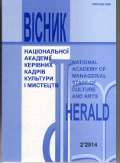THE PRACTICE OF INSTRUMENTS’ SOLO OF THE RENAISSANCE PERIOD AS THE PERFORMING BASIS TO THE GENRE OF MUSIC FOR INSTRUMENT’S SOLO (on an example of wind performing arts)
DOI:
https://doi.org/10.32461/2226-3209.2.2014.137969Keywords:
genre, solo performance, means of music expressive, wind instruments, practice, performing mastery, creationAbstract
In these latter days, the genre of music instrument’s solo is very well-known and requested among a lot of musicians. The genre has considerable attention from famous world composers. Compositions of this genre are topical in very many educational institutions. As a result, composers and performers, teachers and students, music publishers need knowledge about his particularity.
The author of the given article learned creative and esthetical substantiations of instrumental solo practice as the performing basis of the genre of music for instrument’s solo. The writer does it on an example of wind performing arts. The researcher opened this phenomenon of music culture in the Renaissance period. The author of this scientific work used historical, comparative, deductive methods of his research. The main purpose of the given article is popularization of the genre performing features of music for instrument’s solo.
The principal foundation of the instrumental performance was able to develop in that time. As a rule, many musicians played different instruments. They always wrote a lot of musical compositions and variations to famous vocal and instrument themes. They also performed them on the large and little stages. Important to note that fundamental factor of the genre of music for instrument’s solo is individual performing operation. Masterpieces of this genre powerfully activate emotional and creative potential of instrumentalists. The genre of music for instrument’s solo is compositive genre of contemporary music performing art.
On an example of wind performing arts we know about the new instruments as trombone, bassoon. We also know about player of Renaissance period. These are musicians of wind performing arts Giovanni Alvіzі, Bartolomeo Trombonchino, Antonіo del Cornetto, Erhard Borussuma and others.
The main instrumental genres for music solo of the Renaissance were estampі and le. They were born with dance in the union. Instrumentalists could play and sing at the same time. But musicians of wind performing arts could not play and sing simultaneously. Soon instrumental line of very many performers was the main and art defining.
The renaissance’s instrumentalists had an active looking on the art "Ars nova". They intended to make use of new means of expression music. Many of them made original types of wind instruments and brilliantly played them. The instrumental virtuoso passages, phrases, musical sentences and configurations were in very many vocal compositions.
This feature of instrumental playing established virtuosic style of performing art.
The creative competitions among musicians were very popular in the Renaissance period. Performers had got very much mutual enrichment of virtuosic technique, the line of sound, different tone of timbre, the beginning and continuation of sound, the power of tunes. Many instrumentalists made creative contents of piece, determine its style, quality of reverberation and sound, configuration, all means of expression and very many others.
The perspective for the study of the genre of music instrument’s solo is investigation art of improvisation on an example of wind performing arts at different periods of musical culture. Important to note that instruments’ practice is always active for performers on wind instruments.
Downloads
Published
Issue
Section
License
Authors who publish with this journal agree to the following terms:
1. Authors retain copyright and grant the journal right of first publication with the work simultaneously licensed under a Creative Commons Attribution License that allows others to share the work with an acknowledgement of the work's authorship and initial publication in this journal.
2. Authors are able to enter into separate, additional contractual arrangements for the non-exclusive distribution of the journal's published version of the work (e.g., post it to an institutional repository or publish it in a book), with an acknowledgement of its initial publication in this journal.
3. Authors are permitted and encouraged to post their work online (e.g., in institutional repositories or on their website) prior to and during the submission process, as it can lead to productive exchanges, as well as earlier and greater citation of published work (See The Effect of Open Access).


